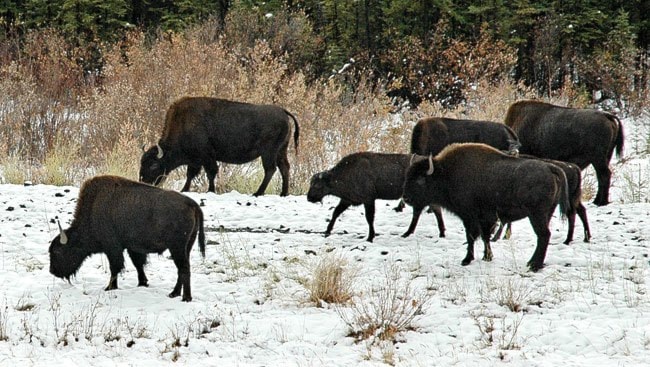Wood bison are listed as “threatened” under Canada’s Species at Risk Act, but here in the Yukon, we have the unusual problem of having too many of the big, burly creatures, according to government biologists.
The territory announced yesterday that it has increased the target size of the Aishihik herd from 500 to 1,000 animals.
Over the years the government has loosened rules to encourage hunting of the rapidly-growing herd.
Until 2008 there was a lottery to allocate hunting permits for bison. Now, any licensed Yukon hunter can purchase a seal.
As of this season the fee for each seal has been lowered from $50 to $10. Anyone who purchased their permit before August 29 can bring their paperwork to an Environment Yukon office for a refund.
Since first being introduced in 1988, the population has exploded to over 1,300, with very little natural predation and in spite of an annual hunting season. And the bison population is still growing at an estimated rate of 18 per cent, said Harvey Jessup with the Yukon Fish and Wildlife Management Board.
The wood bison’s ancestors roamed North America along with the other large ice age mammals since an estimated 90,000 years ago, according to the management plan released by the board yesterday.
Bison numbers declined along with the steppe habitat, which was replaced by the boreal forest. Hunting also helped shrink their ranks.
It is thought that the wood bison were locally extinct in the Yukon by the early 20th century.
The territory became involved in a national plan to restore bison populations in 1980, and between 1988 and 1992 it released 170 animals in the Aishihik region.
The original plan called for the herd to be kept at no more than 500 animals, to contain the unknown effects that they could have on the environment and nearby communities.
When the herd hit that number in 1998, hunting permits were issued for their harvest for the first time. Since then, 1,259 bison have been shot by hunters.
Some recent evidence has shown that bison have been preyed upon by wolves, but that is still rare.
There are several reasons to carefully contain both the territory and the numbers of the herd, said Jessup.
First, there’s little information available about bisons’ effects on the territory’s plants and wildlife.
“Some of the local people have concern that (bison) haven’t been on the land for several hundred years, so how is that going to affect moose, caribou, sheep?” said Jessup.
Limited studies have been conducted on the possible interference between the bison and caribou populations, but they leave many questions unanswered.
Secondly, bison can be dangerous when they come into conflict with people and properties.
“For example, they knock down fences, they push over outhouses, that kind of stuff. They have trampled on grave sites,” said Jessup.
And, of course, bison present a grave danger to motorists when they come near the highway. For that reason the new management plan calls for a bison-free zone to be established south of the Alaska Highway.
The range of the animal must also be contained to help ensure the safety of the herd itself.
Contact with plains bison, a separate species of which several herds roam free in Alaska, could spell disaster for the wood bison. There is also a risk of disease spreading between herds.
The increase in the target maximum herd size reflects the reality of the current population, said Jessup. The National Wood Bison Recovery Team had also called for the herd to be kept at a minimum of 1,000 animals to ensure the genetic integrity of the herd in the long run, he said.
Some hunters have complained that the bison have become more difficult to hunt since harvesting of the herd began in 1998.
That’s no different from other hunted animals, Jessup said.
“Like other animals that are hunted, they just become more wary. They learn. And the bison have done that.”
The plan will be reviewed in five years. Until then, officials hope that lowering barriers to hunting will be enough to keep the bison in check.
“It’s another opportunity, it’s another big game animal that Yukoners can harvest. And so far, we’ve heard that people do like hunting them, and do like putting the meat in the freezer,” Jessup said.
Contact Jacqueline Ronson at
jronson@yukon-news.com
